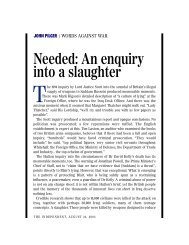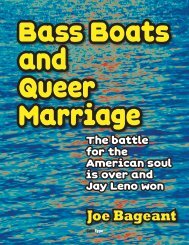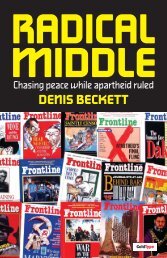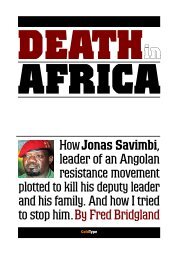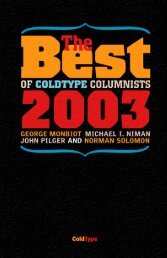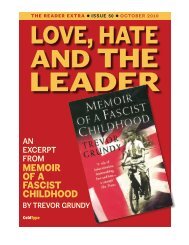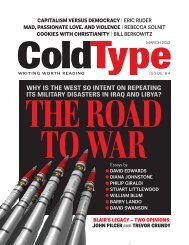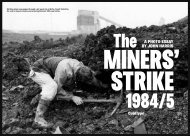You also want an ePaper? Increase the reach of your titles
YUMPU automatically turns print PDFs into web optimized ePapers that Google loves.
Eyewitness Rwanda<br />
CONTINUED FROM FRONT PAGE<br />
You can try to evoke the eerie unreality of seeing a single<br />
arm poking out from the packed dirt of a mass grave containing<br />
hundreds of bodies. Or walking through a city in<br />
which every occupant is a corpse.<br />
But no medium can capture the confluence of sense at<br />
riot. You can’t describe each expression of shock and pain<br />
on each decaying face.<br />
You can’t begin to convey the thick, dense lingering odor<br />
of human decay that clings to the clothes and seems to have<br />
its own taste. You can’t replay for the reader the soundtrack<br />
of a hundred thousand flies so bloated from feeding that<br />
they can barely stay aloft. You can’t count every orphan<br />
wandering the roads alone.<br />
I took three trips to Rwanda between early May<br />
and mid-August last year. Each was a study in the ways a<br />
human being can die. There was the mass starvation, dehydration<br />
and disease at the Rwandan refugee camps in eastern<br />
Zaire — the type of death that was common in Somalia.<br />
There were the shrapnel-torn bodies of uniformed soldiers<br />
killed in battle, the type of death common to any guerrilla<br />
war fought in the bush.<br />
Then there were the robotic massacres in the towns and<br />
villages, the thousands of moments when one group of villagers<br />
suddenly rose up and killed another group with every<br />
device at its disposal: clubs with wooden studs, machetes,<br />
guns, grenades, spears. Even a sharpened umbrella.<br />
This was a special type of killing, among neighbors, up<br />
close and personal. The scope and scale and swiftness of<br />
such remorseless cruelty gave Rwanda its standing among<br />
history’s truly horrible moments.<br />
One day last May, AP photographer Jean-Marc Bouju<br />
and I went to a village where everybody was dead. Perhaps<br />
5,000 bodies lay in the streets, in the schoolrooms, in the<br />
church, in the hospital, outside the maternity clinic. We<br />
wrapped T-shirts over our mouths and noses and forced<br />
ourselves to look inside every building, examine every scene.<br />
We wanted to try to understand.<br />
Families embraced each other in church. A teacher lay<br />
beneath a schoolroom blackboard. A couple clung to each<br />
other beneath a picture of Jesus Christ. A schoolboy, who<br />
looked as if he’d been frozen in terrified motion, lay sprawled<br />
amid overturned desks.<br />
We found some survivors in a refugee camp in a nearby<br />
town. They told us the victims far outnumbered the killers.<br />
Yet most people went to their deaths on their knees, in terrified<br />
obedience.A few days later, we found some people who<br />
confessed to being killers being held by the anti-government<br />
rebels. We asked them the obvious question. Why?<br />
What is strange after spending too much time in Rwanda<br />
is that seemingly incomprehensible events begin to take<br />
on a perverse logic.<br />
Many of the people who killed were illiterate peasants.<br />
They were told that a rebel army was coming to butcher<br />
them. They were told that there were supporters of this army<br />
in their midst. They were told they had to kill these people<br />
before this army arrived or they, and their children, would<br />
soon die horribly.<br />
Many of these people truly believed they were doing their<br />
patriotic duty. Old people dutifully compiled death lists that<br />
showed who had ancestors from the rival ethnic group. Children<br />
listened to the conversations of their playmates’ parents,<br />
trying to detect whether they said anything negative<br />
about the government.<br />
When the radio said it was time to kill the people<br />
COLDTYPE<br />
While the men dealt with the adults, the women<br />
in her town gathered up the children of the families<br />
deemed to be enemies. They put them in a circle<br />
and began pounding their heads with bulbous clubs<br />
designed for this unfathomable task<br />
opposed to the government, the masses slid off a dark edge<br />
into insanity.<br />
Women were raped before and during their deaths. Eyes<br />
were gouged out, testicles cut off, babies decapitated, pregnant<br />
women speared through the womb.<br />
One mother of five told me how she killed two of her<br />
neighbor’s children. While the men dealt with the adults, the<br />
women in her town gathered up the children of the families<br />
deemed to be enemies. They put them in a circle and began<br />
pounding their heads with bulbous clubs designed for this<br />
unfathomable task. “They didn’t have time to scream,” the<br />
woman told me. “They just made big eyes.”<br />
A man told me how he killed two of his old schoolmates,<br />
who screamed that they were his friends as he slashed them<br />
with his machete.<br />
In much of Africa, women grind a root called cassava into<br />
a paste by using what are essentially huge mortars and pestles.<br />
The pestles are like clubs and the mortars are about the<br />
size of a bassinet. A young student I spoke with said he saw<br />
babies being placed in these mortars and ground to a bloody<br />
pulp.<br />
Almost overlooked amid the death in Rwanda is the large<br />
number of people permanently maimed.<br />
I met an Italian doctor who spent his entire day ampu-<br />
PAGE 2<br />
ILLUSTRATION: ANDREW PEYCHA<br />
tating gangrenous limbs, some of them<br />
crawling with maggots. At one point in his<br />
tour, after he felt he’d seen everything, a<br />
man staggered into the clinic with his brain<br />
clearly visible through a deep machete gash<br />
in his head. “I couldn’t save him,” the doctor<br />
said.<br />
The civil war and the massacres, of<br />
course, triggered one of the worst refugee<br />
crises of the post-World War II era. There<br />
were great crosscurrents of people who<br />
seemed to alight en masse virtually<br />
overnight.<br />
I don’t know how many times I would<br />
travel down a road that I’d traveled a day<br />
or two before and see 50,000 or 100,000<br />
people setting up camp, seemingly appearing<br />
out of nowhere.<br />
Amid the sickness and death, a simple,<br />
mundane sign of normalcy, even happiness,<br />
was a jolt. Early one morning in the<br />
southern town of Cabbing, I was awakened<br />
by the sound of children singing.<br />
On an otherwise empty street, a dozen<br />
youngsters from a refugee camp down the<br />
road were walking to a new well on the other<br />
side of town, carrying and clanking<br />
together a motley collection of scavenged<br />
water containers.<br />
They had passed a mass grave. They<br />
had passed destroyed homes of murdered<br />
people. They even had passed men who<br />
harassed them because some of the children<br />
were members of the Tutsi minority.<br />
Eight of the 12 had lost parents in the massacres.<br />
One 10-year-old girl had watched men<br />
drown her father in a cattle dip. She had<br />
watched them take her mother away to<br />
what was likely an even more prolonged<br />
and tormented fate. All these kids had<br />
seen the most horrible things a human<br />
being can experience. And yet, on a sunny<br />
day in the company of themselves, these<br />
children found a reason to sing.<br />
Toward the end of my<br />
first tour, after I’d grown accustomed to seeing hundreds of<br />
bodies in every possible configuration of death, I reached a<br />
small moment of personal truth. I was traveling from the<br />
capital Kigali, when we passed what appeared to be a boy no<br />
more than 15 years old who had been dead for a few weeks<br />
on the shoulder of the highway. I gave the corpse such a passing,<br />
casual glance that moments later I was rattled by my<br />
own reaction. I’d lost the ability to be appalled, and it was<br />
time to move on to another assignment.<br />
Human cruelty is not infinite in degree, I believe. It has a<br />
ceiling, a wall, a point at which violence and horror reach a<br />
saturation point, where pain and death reach the apex of<br />
pointlessness and any further depravity becomes redundant.<br />
That level, that ceiling, that ultimate degree of cold inhumanity,<br />
I think, was reached in Rwanda. ■<br />
Mark Fritz won a Pulitzer Prize for his reporting for<br />
Associated Press West African during the Rwanda ethnic<br />
massacres. His reporting from that conflict also earned him<br />
an ASNE deadline award. Fritz is now a national writer for<br />
AP, based in New York. This article, reprinted from the<br />
magazine IPI Report, was originally given as a speech<br />
to an AP Managing Editors conference.



